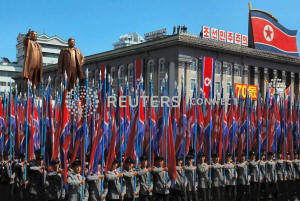|
North Korea may have made more nuclear
bombs, but threat reduced: study
 Send a link to a friend
Send a link to a friend
 [February 12, 2019]
By David Brunnstrom [February 12, 2019]
By David Brunnstrom
WASHINGTON (Reuters) - North Korea has
continued to produce bomb fuel while in denuclearization talks with the
United States and may have produced enough in the past year to add as
many as seven nuclear weapons to its arsenal, according to a study
released just weeks before a planned second summit between the North
Korean leader and U.S. President Donald Trump.
However, the country's freeze in nuclear and missile testing since 2017
mean that North Korea's weapons program probably poses less of a threat
than it did at the end of that year, the report by Stanford University's
Center for International Security and Cooperation found.
Siegfried Hecker, a former director of the U.S. Los Alamos weapons
laboratory in New Mexico who is now at Stanford and was one of the
report's authors, told Reuters analysis of satellite imagery showed
North Korea's production of bomb fuel continued in 2018.

He said spent fuel generated from operation of the 5 megawatt reactor at
its main nuclear plant at Yongbyon from 2016-18 appeared to have been
reprocessed starting in May and would have produced an estimated 5-8 kg
of weapons-grade plutonium.
This combined with production of perhaps 150 kg of highly enriched
uranium may have allowed North Korea to increase the number of weapons
in its arsenal by between five and seven, the Stanford report said.
Hecker's team had estimated the size of North Korea's arsenal in 2017 at
30, bringing a possible current total of 37 weapons. U.S. intelligence
is not certain how many nuclear warheads North Korea has. Last year, the
Defense Intelligence Agency was at the high end with an estimate of
about 50 nuclear warheads, while analysts have given a range of 20-60.
The Stanford report said that while North Korea was likely to have
continued work on warhead miniaturization and to ensure they can stand
up to delivery via intercontinental ballistic missiles, the halt in
testing greatly limited its ability to make such improvements.
"They have continued the machinery to turn out plutonium and highly
enriched uranium," Hecker said, "but it also depends on weaponization -
the design, build and test and then the delivery.
"When they ended missile testing, those things rolled backwards. So when
I look at the whole spectrum, to me North Korea ... is less dangerous
today than it was at the end of 2017, in spite of the fact that they may
have made another five to seven weapons worth of nuclear material."
[to top of second column]
|

People carry flags in front of statues of North Korea founder Kim Il
Sung (L) and late leader Kim Jong Il during a military parade
marking the 70th anniversary of North Korea's foundation in
Pyongyang, North Korea, September 9, 2018. REUTERS/Danish Siddiqui

The Stanford experts said it was their assessment that "North Korea
cannot deliver a nuclear warhead with any measure of confidence to
the U.S. mainland," although Hecker said its nuclear weapons were a
real threat to Japan and South Korea.
Hecker said it was understandable that North Korea should have
continued its weapons work, given that it had reached no specific
agreement in the latest talks with the United States to stop that
work.
U.S. Secretary State Mike Pompeo told Congress in July that North
Korea was continuing to produce fuel for nuclear bombs in spite of
its pledge to denuclearize, even as he argued - as he has continued
to do - that the Trump administration was making progress in talks
with Pyongyang.
North Korean leader Kim Jong Un pledged during an unprecedented
first summit with Trump last June to work towards denuclearization
of the Korean peninsula.
There has been little concrete progress since, but in September, Kim
expressed willingness to take steps, including the permanent
dismantlement of nuclear facilities at Yongbyon, in return for
"corresponding measures" by the United States.
U.S. Special Representative for North Korea Stephen Biegun held
three days of talks in Pyongyang last week to prepare for a second
Trump-Kim summit due to be held in Hanoi on Feb. 27 and 28. He said
before the talks they would include discussion of corresponding
steps North Korea has demanded.

Trump described those talks as "very productive" but the State
Department has offered no sign of progress and Biegun and his
counterpart have agreed to meet again before the summit.
(Editing by Simon Cameron-Moore)
[© 2019 Thomson Reuters. All rights
reserved.]
Copyright 2019 Reuters. All rights reserved. This material may not be published,
broadcast, rewritten or redistributed.
Thompson Reuters is solely responsible for this content. |